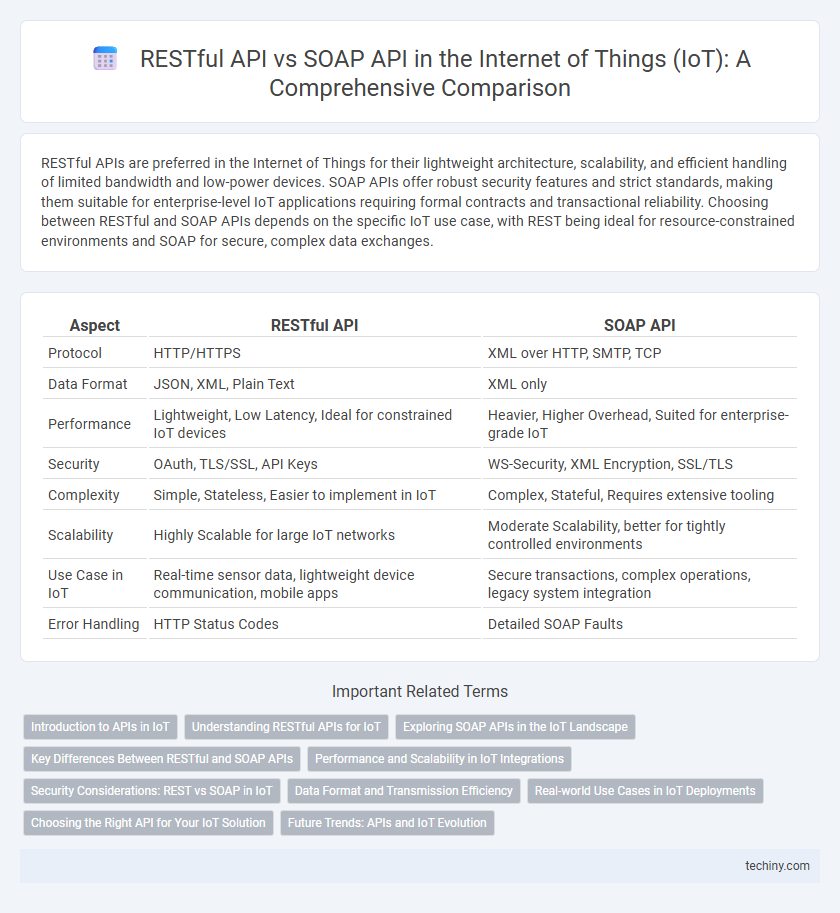RESTful APIs are preferred in the Internet of Things for their lightweight architecture, scalability, and efficient handling of limited bandwidth and low-power devices. SOAP APIs offer robust security features and strict standards, making them suitable for enterprise-level IoT applications requiring formal contracts and transactional reliability. Choosing between RESTful and SOAP APIs depends on the specific IoT use case, with REST being ideal for resource-constrained environments and SOAP for secure, complex data exchanges.
Table of Comparison
| Aspect | RESTful API | SOAP API |
|---|---|---|
| Protocol | HTTP/HTTPS | XML over HTTP, SMTP, TCP |
| Data Format | JSON, XML, Plain Text | XML only |
| Performance | Lightweight, Low Latency, Ideal for constrained IoT devices | Heavier, Higher Overhead, Suited for enterprise-grade IoT |
| Security | OAuth, TLS/SSL, API Keys | WS-Security, XML Encryption, SSL/TLS |
| Complexity | Simple, Stateless, Easier to implement in IoT | Complex, Stateful, Requires extensive tooling |
| Scalability | Highly Scalable for large IoT networks | Moderate Scalability, better for tightly controlled environments |
| Use Case in IoT | Real-time sensor data, lightweight device communication, mobile apps | Secure transactions, complex operations, legacy system integration |
| Error Handling | HTTP Status Codes | Detailed SOAP Faults |
Introduction to APIs in IoT
RESTful APIs are widely favored in Internet of Things (IoT) due to their lightweight architecture, which enables efficient communication between constrained devices and cloud services. SOAP APIs, while offering robust security and standardized protocols, often incur higher overhead, making them less suitable for resource-limited IoT environments. Choosing between RESTful and SOAP APIs depends on specific IoT application requirements such as scalability, device capability, and integration complexity.
Understanding RESTful APIs for IoT
RESTful APIs in IoT enable seamless communication between devices and cloud services by leveraging stateless, lightweight HTTP protocols, which enhance scalability and reduce latency. Their resource-oriented architecture supports various data formats like JSON and XML, facilitating efficient data exchange and integration with web technologies. RESTful APIs are preferred over SOAP APIs in IoT due to simpler implementation, better performance, and compatibility with constrained devices and low-bandwidth networks.
Exploring SOAP APIs in the IoT Landscape
SOAP APIs in the IoT landscape offer robust, standardized protocols ideal for complex transactions and secure communications between devices and systems. Their extensive WS-* standards support reliability, security, and transaction compliance, making them suitable for industrial IoT applications requiring strict data integrity. Despite heavier payloads compared to RESTful APIs, SOAP's ability to handle asynchronous processing and built-in error handling enhances interoperability in heterogeneous IoT environments.
Key Differences Between RESTful and SOAP APIs
RESTful APIs in the Internet of Things (IoT) offer lightweight, stateless communication using standard HTTP methods and JSON format, enabling faster and more scalable interactions between devices. SOAP APIs provide a protocol-driven approach with built-in security features such as WS-Security, making them suitable for applications requiring strict compliance and complex transactional reliability. The primary differences lie in REST's simplicity and efficiency for resource-constrained IoT environments versus SOAP's robustness and formal contract-based messaging ideal for enterprise-level IoT integrations.
Performance and Scalability in IoT Integrations
RESTful APIs provide lightweight communication with lower latency and reduced bandwidth usage, crucial for resource-constrained IoT devices. SOAP APIs, though offering robust security and standardized messaging, tend to introduce higher overhead, limiting performance in large-scale IoT deployments. Scalability favors RESTful APIs due to their stateless nature, enabling efficient handling of numerous IoT endpoints and dynamic data exchange.
Security Considerations: REST vs SOAP in IoT
RESTful APIs in IoT prioritize lightweight communication and typically rely on HTTPS and OAuth 2.0 for security, enabling efficient, secure data exchange with reduced overhead. SOAP APIs offer robust security features such as WS-Security, supporting encryption, digital signatures, and authentication, which is critical for sensitive IoT applications requiring comprehensive message-level security. The choice between REST and SOAP in IoT hinges on balancing security needs against performance constraints, with REST favored for scalability and simplicity, while SOAP suits environments demanding stringent security compliance.
Data Format and Transmission Efficiency
RESTful APIs in IoT primarily utilize lightweight data formats like JSON, which enhance transmission efficiency and reduce bandwidth usage for constrained devices. SOAP APIs rely on XML, resulting in larger message sizes that can increase latency and processing overhead in IoT networks. Efficient data formatting and reduced transmission loads make RESTful APIs more suitable for real-time, resource-limited IoT environments.
Real-world Use Cases in IoT Deployments
RESTful APIs dominate IoT deployments due to their lightweight architecture, which enables efficient communication between constrained devices and cloud services, exemplified by smart home automation systems leveraging REST to transmit sensor data rapidly and seamlessly. SOAP APIs find use in enterprise IoT scenarios requiring strict standards, security, and transactional reliability, such as industrial IoT applications in manufacturing plants where robust message integrity and formal contracts ensure accurate machinery monitoring and control. Real-world IoT deployments favor RESTful APIs for scalability and ease of integration, while SOAP remains essential where compliance with complex protocols and enterprise-grade security is critical.
Choosing the Right API for Your IoT Solution
RESTful APIs offer lightweight, scalable, and stateless communication ideal for IoT devices with limited resources, enabling efficient data exchange and real-time interactions. SOAP APIs provide robust security features and standardized protocols, making them suitable for complex enterprise IoT systems requiring strict transaction compliance. Selecting the right API depends on device capabilities, security requirements, and the scalability needs of the IoT solution.
Future Trends: APIs and IoT Evolution
RESTful APIs dominate IoT development due to lightweight architecture, scalability, and compatibility with web standards, facilitating seamless device communication and data exchange. While SOAP APIs offer robust security and standardized messaging, their complexity and overhead limit adoption in resource-constrained IoT devices. Future trends emphasize RESTful API enhancements through protocols like MQTT and CoAP, enabling real-time responsiveness and interoperability across heterogeneous IoT ecosystems.
RESTful API vs SOAP API (in IoT context) Infographic

 techiny.com
techiny.com